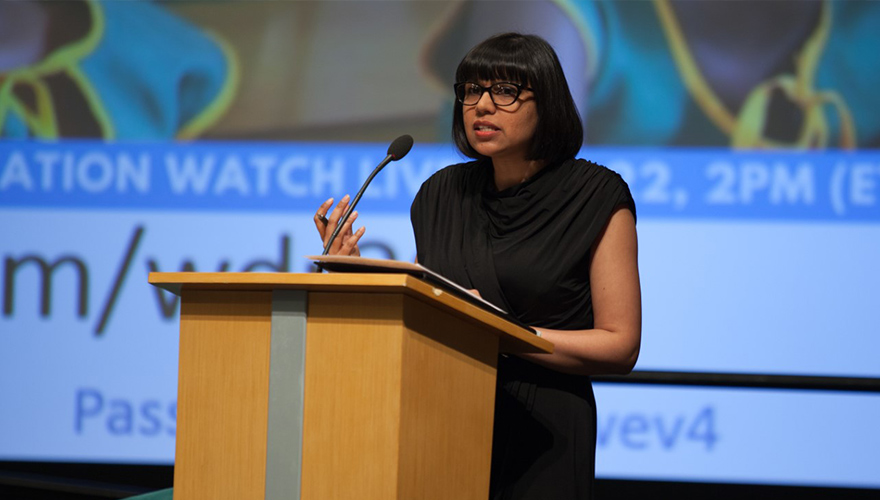
Professor Prachi Srivastava discusses low-fee private schools at a special event held by the World Bank in Washington D.C. Feb. 22. Photo credit: A’melody Lee/World Bank

Professor Prachi Srivastava discusses low-fee private schools at a special event held by the World Bank in Washington D.C. Feb. 22. Photo credit: A’melody Lee/World Bank
Globally, about 250 million children can’t read or write after completing four years of school. Evidence shows it made no difference if those schools were public or private institutions; the student outcomes were the same.
And yet, a trend has emerged in recent years where donors – be they international governments, aid agencies, multilateral banks or even private investors – have started investing in private actors, including for-profit companies, to help them set up private, low- fee schools in the world’s developing nations, aka the Global South.
The assumption behind funding private schools is that they can do better for students than public schools in these countries. But Prachi Srivastava, Associate Professor at Western’s Faculty of Education, says things are not so black and white.
“The global trend towards privatizing education in the Global South is a curious one, because we just can’t make a firm assessment that private is better than public,” she said. “There is no study that shows universally across the board that private schools, including low-fee private schools, are better in terms of student outcomes.”
Srivastava, a leading scholar and researcher in education and international development, specializes in researching low-fee schools. She has just returned from Washington D.C. where she debated the issue at a special event organised by the World Bank. The international multilateral development bank provides financial and technical assistance to developing countries around the world, and is the largest donor to education globally.
The event was part of the World Bank’s Africa Knowledge Fest, and was designed to investigate the trend of supporting low-fee private schooling.
“We debated whether organizations like the World Bank should subsidise these types of private schools and fund these types of private companies,” said Srivastava. “And on a larger level, discussed the appropriateness and the repercussions of private providers coming into education in the Global South.”
Srivastava coined the term “low-fee private schools” in the early part of her career as one of the first researchers to explore the field. The term, as she coined it, represents schools that charge no more per month for tuition than a family would earn in a day.
However, many of the private schools billing themselves as low-fee are charging more than this, and even those charging less are still often out of reach for many families.
“Thirty cents a month to access a school may sound cheap, but for families making only a dollar a day, with no guarantee of long-term work, it’s a significant cost,” said Srivastava. “We know from research that these families either won’t enroll, or they will inevitably drop out because they can’t sustain the payments.”
Education problems in the Global South are complicated. A number of countries do not have universal enrollment in elementary education, meaning not all children attend school, even at the basic levels. Those who do are faced with challenges like overcrowded schools, lack of roads on which to travel and, in conflict zones, the dangers of attending schools that are increasingly becoming targets of violence.
Many countries prioritize their own resources in areas other than education, so official development assistance and international aid from the world’s wealthier donor countries becomes an important source of revenue for education. As such, the idea behind investing in private education providers becomes even more complex.
“There are examples of governments from wealthier nations contemplating, or already investing, aid money in private, for-profit corporations who want to run these low-fee schools in developing countries,” said Srivastava. “But taxpayers from the funding nations are asking, why not fund public systems in those countries themselves?”

A low-fee private school in Lucknow District, India.
Some countries have even decided to hand over and subsidise a proportion of their schools to private companies.
“We must ask, why they are doing this. On what basis did they make the assumption that private schools will be able to do a better job?” said Srivastava. “There’s no evidence, and until there is, these types of decisions cannot not be made lightly.”
Srivastava has been continuing her research into low-fee private schools and the evolution of this sector globally as part of a major international collaborative project on the right to education and non-state private actors funded by the Canadian Social Sciences and Humanities Research Council (SSHRC). She plans to continue liaising with international organizations like the World Bank to raise an important question: why invest such significant amounts of money into a system that can’t show it does better for everyone across the board?
For now, it is a question that remains unanswered.
For more information on Dr. Srivastava and her work, visit her website: http://www.prachisrivastava.com